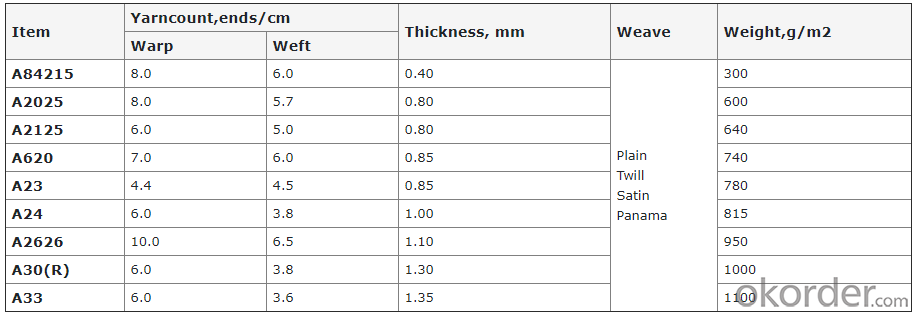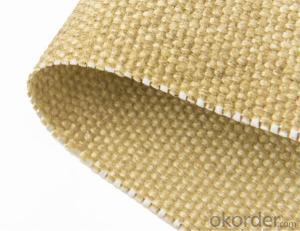Fireproof Fiberglass Cloth Coated With Vermiculite
- Loading Port:
- Ningbo
- Payment Terms:
- TT OR LC
- Min Order Qty:
- 500 m²
- Supply Capability:
- 300000 m²/month
OKorder Service Pledge
OKorder Financial Service
You Might Also Like
Description: Vermiculite coated fiberglass fabrics is mainly composed of alkali-free glass fiber and vermiculite, in which glass fiber is the substrate and vermiculite is the coating material. Vermiculite is a natural mineral. The vermiculite coating makes the composite glass fiber cloth resistant to high temperature in a short time to 1000℃ and continuous temperature resistance to 800℃.In the production process, the vermiculite is uniformly coated on the fiberglass products, and then dried in the subsequent process, the vermiculite settles on the fiberglass products, so as to produce coated vermiculite glass of different thicknesses and specifications Fiber products. At the same time, the glass fiber cloth has stronger fire breakdown resistance and friction resistance, and good mechanical processing performance.
Features: High Temperatures And Abrasion Resistant, Heat Protection
Application: high temperature gloves, high-temperature gaskets, and other high-temperature personal protective equipment, insulation blankets, welding blankets, welding pads, thermal protection, high temperature lagging, high temperature sealing, fire curtains, thermal insulation curtain, expansion joints

PRICE: USD7 per square meter
UNIT: square meter
MOQ: 500 square meters
Weight: 600gsm-3000gsm or customized
Width: 0.9m-2m or customized
Yarn Type: E-glass
Standing temperature: 850℃-1000℃
Product name: Vermiculite coated fiberglass fabric
Coating/Finish/Surface Treatment: Vermiculite coated
Roll length: 50 meter or customized
Color: Yellow
Weave Type: plain woven
Alkali content: Alkali free
Processing service: cutting
Material: fiberglass fabric, Vermiculite
Thickness: 0.6mm to 3mm
Size: can be customized
Supply ability: 300000 meters per month
Packaging: Vermiculite coated fiberglass fabrics rolls covered with film packed in cartons loaded on pallets or according to customers' requirements.
Lead time: 7-30 days
- Q:What is the width range of fiberglass fabric?
- The width range of fiberglass fabric can vary depending on the manufacturer and intended use. However, most commonly, fiberglass fabric is available in widths ranging from 30 inches to 60 inches. Some specialty fabrics may be available in wider widths, up to 100 inches or more. It is important to check with the specific manufacturer or supplier for the available width options for a particular fiberglass fabric.
- Q:Can fiberglass fabric be used for making signs and banners?
- Yes, fiberglass fabric can be used for making signs and banners. Fiberglass fabric is a versatile material that offers several advantages for this purpose. It is lightweight, durable, and resistant to both weather conditions and UV radiation. These properties make it suitable for outdoor applications, ensuring that signs and banners made from fiberglass fabric can withstand the elements and maintain their appearance for a long time. Additionally, fiberglass fabric can be easily printed on, allowing for vibrant and eye-catching designs. Its flexibility also enables it to be easily manipulated and shaped, making it a versatile choice for creating various sign and banner designs. Overall, fiberglass fabric is a reliable and effective material for making signs and banners due to its durability, weather resistance, and printability.
- Q:What is the abrasion resistance of fiberglass fabric?
- Fiberglass fabric possesses a high level of abrasion resistance, making it well-known for its capacity to endure repeated friction and wear without incurring substantial damage. Its sturdy and long-lasting nature renders it suitable for applications that require crucial abrasion resistance, including the production of protective clothing, industrial curtains, and reinforcing materials for composites. The actual level of abrasion resistance in fiberglass fabric may vary depending on its construction, finish, and any additional coatings or treatments applied. Nonetheless, fiberglass fabric is universally acknowledged for its superb resistance to abrasion, resulting in its widespread use in industries that prioritize durability.
- Q:Can fiberglass fabric be used for packaging?
- Yes, fiberglass fabric can be used for packaging. It is a strong and durable material that can provide excellent protection for fragile items during transportation and storage. Additionally, it is resistant to heat, moisture, and chemicals, making it suitable for various packaging applications.
- Q:Can fiberglass fabric be used for reinforcement in composite materials?
- Indeed, composite materials can benefit from the inclusion of fiberglass fabric as reinforcement. Fiberglass is widely employed in composites owing to its impressive ratio of strength to weight, resistance to corrosion, and endurance. Typically, the fabric consists of delicate glass fibers expertly interwoven, granting it exceptional tensile strength and adaptability. When combined with a matrix material like epoxy resin, the fiberglass fabric fortifies the composite structure, thereby improving its mechanical characteristics. Consequently, fiberglass fabric emerges as an optimal selection for industries such as aerospace, automotive, construction, and marine, where the need for lightweight, robust, and enduring materials is paramount.
- Q:How does fiberglass fabric handle UV degradation?
- Fiberglass fabric is highly resistant to UV degradation. It is designed to withstand prolonged exposure to sunlight without deteriorating or breaking down. The unique composition of fiberglass, with its woven strands of glass fibers, provides excellent protection against the damaging effects of UV radiation. This makes fiberglass fabric a durable and long-lasting material for various applications, including outdoor use.
- Q:How does fiberglass fabric perform in fire-resistant applications?
- Due to its inherent properties, fiberglass fabric is an exceptional option for fire-resistant applications. Unlike other materials, fiberglass fabric does not burn or support combustion when exposed to fire. It maintains its structural integrity even at high temperatures due to its high melting point. Moreover, when fiberglass fabric is exposed to fire, it does not release toxic gases or smoke. This characteristic makes it a safe choice for fire-resistant applications, especially in enclosed spaces. The absence of toxic fumes helps prevent health risks and ensures a secure evacuation. Additionally, fiberglass fabric offers various advantages beyond its fire resistance. It is lightweight and flexible, making it easy to handle and install. Furthermore, it is highly durable and resistant to chemicals, moisture, and UV radiation. In conclusion, fiberglass fabric proves to be an excellent option for fire-resistant applications. Its ability to withstand high temperatures, non-combustible nature, and resistance to toxic fumes make it a reliable and safe solution. Industries such as construction, automotive, aerospace, and manufacturing can greatly benefit from its fire protection capabilities.
- Q:Can fiberglass fabric be used for making stage curtains?
- Yes, fiberglass fabric can be used for making stage curtains. Fiberglass fabric is a versatile material that offers several benefits for stage curtains. Firstly, it is lightweight and durable, making it easy to handle and resistant to wear and tear. This is important for stage curtains as they need to withstand frequent opening and closing during performances. Additionally, fiberglass fabric is flame retardant, ensuring the safety of the stage and performers. It also provides excellent acoustic properties, helping to absorb sound and improve the acoustics in the theater. Moreover, fiberglass fabric is available in a variety of colors and can be easily painted or printed on, allowing for customization and artistic expression. Overall, fiberglass fabric is a suitable choice for making stage curtains due to its durability, fire resistance, acoustic properties, and aesthetic flexibility.
- Q:Are fiberglass fabrics suitable for use in the renewable energy sector?
- Yes, fiberglass fabrics are suitable for use in the renewable energy sector. Fiberglass fabrics are known for their high strength and durability, making them ideal for various applications in renewable energy. One of the key uses of fiberglass fabrics in the renewable energy sector is in the manufacturing of wind turbine blades. Fiberglass fabrics are used to reinforce the blades, providing them with the necessary strength to withstand high winds and turbulent conditions. The lightweight nature of fiberglass also allows for longer blades, resulting in increased energy output. Additionally, fiberglass fabrics are used in the production of solar panels. They are often used as a protective layer to encapsulate the photovoltaic cells and provide insulation. Fiberglass fabrics offer excellent electrical insulation properties, ensuring the longevity and efficiency of solar panels. Moreover, fiberglass fabrics are used in the construction of thermal insulation materials for solar water heaters and geothermal systems. These fabrics help to retain heat, thereby increasing the efficiency of these renewable energy systems. Furthermore, fiberglass fabrics are resistant to corrosion and have a long lifespan, making them suitable for use in marine renewable energy projects such as wave energy converters and tidal turbines. These fabrics can withstand the harsh marine environment and provide structural support to these devices. In conclusion, fiberglass fabrics have numerous applications in the renewable energy sector. Their strength, durability, electrical insulation properties, and resistance to corrosion make them an excellent choice for various renewable energy technologies, including wind turbines, solar panels, thermal insulation materials, and marine energy devices.
- Q:How much glass fiber cloth and how much epoxy resin does it take to make a square meter of fiberglass?
- However, these data are probably different, each kind of resin viscosity (thin consistency), the more concentrated the resin will use more, and alkali content of different fiber, eat the amount of resin will be different, good eating fiber resin will be a little less.
1. Manufacturer Overview |
|
|---|---|
| Location | |
| Year Established | |
| Annual Output Value | |
| Main Markets | |
| Company Certifications | |
2. Manufacturer Certificates |
|
|---|---|
| a) Certification Name | |
| Range | |
| Reference | |
| Validity Period | |
3. Manufacturer Capability |
|
|---|---|
| a)Trade Capacity | |
| Nearest Port | |
| Export Percentage | |
| No.of Employees in Trade Department | |
| Language Spoken: | |
| b)Factory Information | |
| Factory Size: | |
| No. of Production Lines | |
| Contract Manufacturing | |
| Product Price Range | |
Send your message to us
Fireproof Fiberglass Cloth Coated With Vermiculite
- Loading Port:
- Ningbo
- Payment Terms:
- TT OR LC
- Min Order Qty:
- 500 m²
- Supply Capability:
- 300000 m²/month
OKorder Service Pledge
OKorder Financial Service
Similar products
New products
Hot products
Related keywords




























